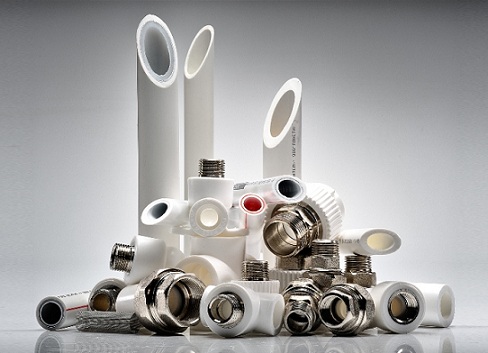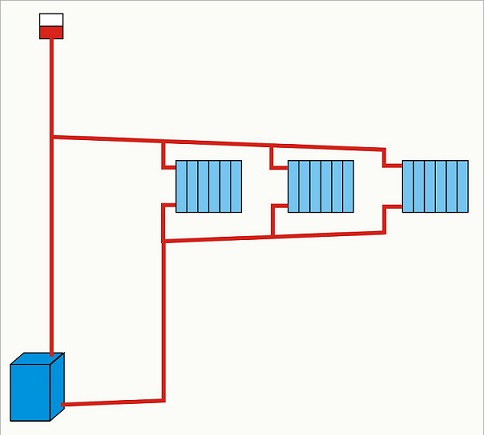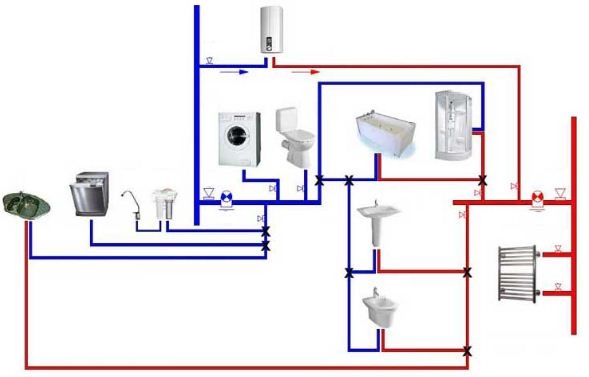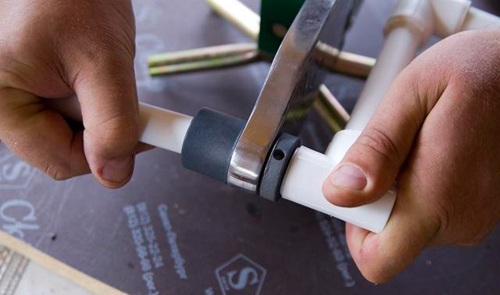Today, not a single private home can be imagined without a water supply system. And we are talking not only about large and beautiful cottages, but also about simple country houses.
The water supply system of a private house can be designed in different ways, that is, there is more than one scheme, but the principles of the device always remain the same.
Water supply diagram in a private house
Indeed, any water supply scheme can be taken as a basis, if we consider it from the point of view of appearance or the presence of any individual elements in it, for example, a hydraulic accumulator. However, according to the method of connecting consumers, the scheme is divided into only two types:
- A diagram where the consumers are connected in series;
- A diagram where the consumers are connected in parallel.
A circuit with a series connection is perfect for installing water supply systems in a small private house, the area of which is small and there are not many consumers in it. This is so because a serial connection implies that the water supply goes from one consumer to another, that is, first from the source, then, for example, to the washbasin, from the washbasin to the sanitary unit, and so on.
This connection leads to the fact that when the first 2-3 consumers are turned on, there is practically no pressure in the last one.
The installation of water supply systems in a private house according to this scheme is quite simple. From the source, the water supply goes to the first consumer. A tee is installed on the pipe, that is, one input and two outputs to this consumer, and to all other consumers.
A parallel scheme implies a slightly different connection of consumers. This scheme includes such an element as a collector. From this collector a water pipeline is laid to each of the consumers.
It must be said that the connection of water supply systems according to both of these schemes can be carried out, both from central water supply systems and from a well or well.

So, in general, the composition of water supply systems is as follows:
- Source (the watershed can be made from central water supply systems, a well or a well);
- Pump or pumping station (only for a well or well);
- It is desirable to have a hydraulic accumulator that will accumulate water;
- A water filter that will purify it;
Advice! It is recommended to install a tee with shut-off valves immediately after the hydraulic accumulator. In this case, one outlet is used for water supply for the house, and the other for water supply for the garden. In this case, naturally, the filter must be installed on the outlet that is used for the water supply of the house.
- After various filters, it is necessary to make another tee, which will separate the future hot and cold water supply;
- Next, the cold water pipe is connected to the cold water collector. The collector, in turn, must contain shut-off valves at each individual outlet;
- The hot water supply should be routed to the heater. This can be a gas boiler or a heating boiler;
- The hot water pipe must be routed to the hot water collector.
It must be said that the system may also contain other elements, for example, a pressure sensor, automatic pumping station and others.
Using a well or well
As can be seen from all of the above, there is nothing complicated about installing water supply systems in a private home. The biggest difficulties arise at the stage of constructing a well or borehole.

In general, initially there is a question of choice - to take water for a private house from a well or well. Of course, digging a well is much easier, since its depth rarely reaches even 10 meters. But the depth of the well sometimes reaches 30.
However, the water from the well is quite contaminated, so the water supply must contain several filters at once - coarse and fine.
The well will require the purchase of a more expensive submersible pump.
In general, water supply in a private house from a well will look like this:
- Submersible pump;
- Adapter (nipple);
- Non-return valve, which serves to prevent water from flowing back;
- Pipe;
- Shut-off valves;
- Filter;
- A five-piece to which automation is connected, for example, a pressure switch, and a pressure gauge;
- Hydraulic accumulator.
It must be said that water supply from a well or a well in a private house must be arranged using a hydraulic accumulator.
Do-it-yourself plumbing installation
Installation of a water supply system in a private house must include several successive stages, as well as several preliminary calculations. One of these calculations is to determine the required pipe diameter.
Pipe diameter selection
So, it must immediately be said that an incorrectly chosen diameter leads to undesirable consequences. For example, if it is too small, the water will move noisily. And if it is very large, then some of the pressure is lost and extra money is spent.

Without delving into serious calculations, we can safely say that the diameter of the pipe depends on the length of the water supply system of a private house. Therefore, to make the right choice, you should calculate the total length:
- If it does not exceed 30 meters, then material with an internal diameter of 25 mm will be sufficient;
- If it is more than 30 meters, then it is better to choose 32 mm material;
- If the pipeline is less than 10 meters long, then material with diameters of 16 or 20 mm will be sufficient.
However, that's not all. There is also a pipe for the collector. In many ways, it depends on it whether the water supply system will provide a sufficient amount of liquid to all consumers.
Here you need to accept the fact that one tap passes about 5 liters of liquid in one minute. Then all that remains is to count the number of such consumers and compare them with the following data:
- A diameter of 25 mm passes approximately 30 liters in 1 minute;
- A diameter of 32 mm passes about 50 liters in 1 minute;
- A diameter of 38 mm passes about 75 liters in 1 minute.
Advice! If a family living in a private house consists of 4 or more people, then about 40% should be added to the calculated values, since in such a situation it is not uncommon for all consumers to be involved at once.
Selecting the required material
The installation of a water supply system must first be accompanied not only by calculations of the diameter of the pipes, but also by the choice of the material from which they are made.
Today on the market you can find products made from the following materials:
- Copper;
- Metal-plastic;
- Steel;
- Cross-linked polypropylene.

Products made from each of these materials have their own disadvantages and advantages. For example, copper pipes are very durable and do not corrode. Making a plumbing system out of copper means making it last for decades. The disadvantage is their price.
Metal-plastic products are aluminum pipes that are coated on both sides with a layer of polyethylene. Such products are not afraid of corrosion, deposits do not accumulate inside, polyethylene is also not afraid of open sunlight, as well as various impurities in the liquid. One drawback is that such water supply systems do not allow high temperatures, more than 95 degrees. Therefore, they are best suited for cold water supply systems from a well or well.
Steel products are one of those that occupy the golden mean. They are strong and durable, and relatively inexpensive. However, they are highly susceptible to corrosion. In addition, such products do not have any special devices for installation, so the installation of water supply systems for a private house must be accompanied by threading on each individual element.
Polypropylene materials have not been on the market for long, but have already gained great popularity. They are durable, do not oxidize and are not subject to corrosion. Installing a water supply system for a private home using them is simple and quick. The biggest disadvantage is that connecting them requires a special tool - a soldering iron.
Advice! When choosing polypropylene pipes for hot water supply to a private home, you need to choose those that are reinforced, for example, with fiberglass or aluminum.
How to make a wiring
Distribution is the installation of pipes to all necessary places, that is, to all consumers.

Let's start moving from the source to the consumers. As an example, let's take a more productive parallel wiring diagram.
So, first we connect to the source. If water is taken from a well or borehole, a pump is lowered into it. For a well, choose a submersible one, for a well, a surface one.
Advice! The choice of pump should be based on a parameter such as power or performance.
So, the pipe is connected to the pump, usually with a clamp. Less commonly, a threaded adapter serves as a connector. The same adapter is used when connecting to a central water supply system.
- If the pressure in the system is not able to provide all people with the required amount of liquid;
- If frequent interruptions in water supply occur.
The installation of the hydraulic accumulator is carried out, as a rule, in the highest, but at the same time easily accessible place.
After the hydraulic accumulator, a tee with shut-off valves is installed. From one outlet the installation is carried out to the water heating device, and from the other - to the cold water supply collector.
As noted above, the water supply may have a filter, or even several. It is recommended to install filters before the heating element and before the cold water supply collector.
The water supply is laid from the boiler to the hot water supply collector.
From two collectors, from each circuit, wiring is carried out to consumers.
As for devices such as a pressure gauge and a meter, their installation is handled by the appropriate service, and they are placed at the entrance to the house.

So, to install pipes around the house, various additional elements are used, that is, tees, angles, adapters from one diameter to another, and so on.
When performing such work, you should adhere to the following rules:
- The pipes must be laid bypassing all building structures. If it is not possible to carry it out in this way, then the pipe must pass through the wall in a special glass;
- All elements in a private house should be installed so that they are separated from the walls at a certain distance, for example, 25 mm - this will facilitate the repair procedure;
- If the water supply system has a drain tap or several taps, then a slight slope is made in their direction. The same applies to the hydraulic accumulator;
- When going around an outer corner, the pipe should be placed 15 mm from it, and when going around an internal corner - 40 mm;
- It is best to fasten water supply elements to the walls using special clips, single or double. They are placed at a distance of 2 meters from each other.
Connection of polypropylene pipes
So, as already mentioned, when laying water supply systems made of polypropylene materials, a special tool is required - a soldering iron.

So, the sequence of working with it is as follows:
- The elements for the water supply are cut into pieces of the required length. To do this, it is best to use special scissors, which should be held strictly perpendicular. It must also be said that the same pipes are used for hot and cold water supply systems, that is, reinforced polyethylene;
- On the cut pieces a mark is placed on the welding depth, about 16 mm;
- Welding areas are degreased;
- Install a nozzle of the required diameter on the soldering iron;
- Heat the soldering iron to a temperature of 260 degrees;
- Pieces of pipes are placed on the nozzles, but turning them is prohibited;
- After starting to put on, count 5-7 seconds and remove the pipes from the nozzle;
- The heated pipes are connected to each other, or the water supply and fitting are connected;
- The elements are held in this position for several seconds.
This is how every two elements of the water supply system in a private house are soldered.

